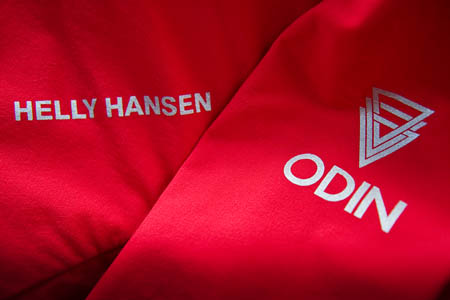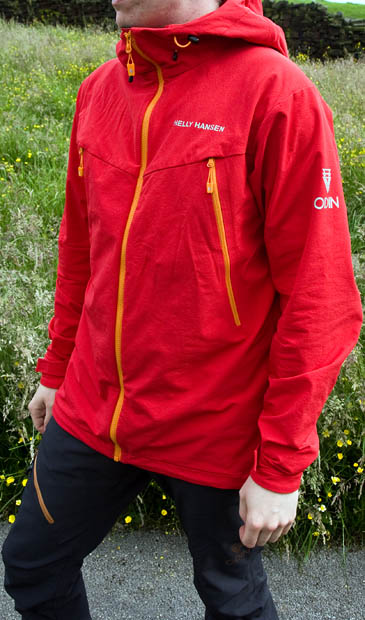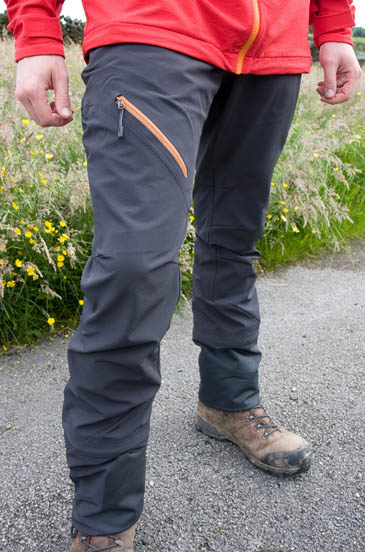Odin Light Softshell Jacket
Weight: 560g
Breathable softshell, material: outer, 91 per cent polyamide; 9 per cent Elastene. Lining: 100 per cent polyester
Colours: men’s redcurrant or ebony; women’s iris or ebony
Price: £140
Country of manufacture: China
Sizes: S, M, L, XL, 2XL
Odin Guide Pant Mark 2
Weight: 700g
Breathable softshell, material: 94 per cent polyamide; 6 per cent Elastene.
Colour: ebony
Price: £220
Country of manufacture: Thailand
Sizes: S, M, L, XL, 2XL
Say Helly Hansen to many outdoor types and they’ll probably come back with something about undies.
The Norwegian company did produce the innovative Lifa baselayers and still does, but there’s more to its range than the familiar wicking layers worn by thousands of fellrunners and other outdoor enthusiasts.
Helly Hansen’s Odin range, named after Thor’s dad, the god of war in Norse mythology, is aimed at serious outdoor enthusiasts, and the Oslo-based firm has enlisted the help of two North American mountain guide companies to develop the range.
Helly Hansen provided an Odin Light Softshell jacket and an Odin Guide Pant Mark 2 for grough to put to the test.
The Odin Light Softshell incorporates one of the guides’ main recommendations: reduce the weight.
Its soft, stretchy fabric makes for a comfortable fit. Our jacket was finished in a bright red, with contrasting yellow YKK zips on both the main fastening and the two pockets, which are positioned high enough to clear rucksack waist straps.
The Odin Light Softshell has a roomy hood, big enough to wear over a helmet, and has separate volume adjuster and tethered side cords. The volume adjuster on the back of the hood has a small plastic tab to help pull but I still had to take my gloves off to pull the cord.
The hood has a soft peak.
The two chest pockets are both big enough to take a laminated OS map, and are mesh, so opening the zips can provide extra ventilation, though I would empty them of content first so you don’t lose anything on the hillside.
The cuffs of the sleeves have Velcro tabs for adjustment and the bottom hem of the jacket also has adjusters to allow it to be cinched in to keep out updraughts.
Like many others, I often wonder where softshell sits in the typical British outdoors enthusiast’s wardrobe. It’s ideal for the kind of cold, dry conditions often found in the Alps or North America, but the UK is more renowned for rain, damp and clag.
We put the Odin Light Softshell jacket and Odin Guide Pant Mark 2 to the test in a variety of environments. A long slog up Scafell in unseasonably cold, windy conditions in May saw the jacket in its ideal environment.
With just a baselayer underneath, I was cool enough on the ascent, much of it off-path and on steep ground, yet on the top, with a stiff breeze, the jacket still felt warm enough with no extra layering.
In fact, in strong winds, the Light Softshell excelled, with a far cosier feeling than, say fleece and there was virtually no wind penetration.
On a shorter jaunt up Pen-y-ghent, I was eager to see how the softshell jacket performed in wetter conditions. Even windier than the Scafell weather, an odd spot or two of rain was shed easily.
As the day got wetter, I decided to push the jacket beyond its normal limits to see just how long I could keep dry without getting the waterproof out, and the Odin Light Softshell did a reasonable job for longer than I expected before the inevitable feeling of dampness crept in.
So I think the Light Softshell would be ideal on those days when an odd brief shower was expected as it obviates the irritating need to be constantly putting on and taking off a waterproof in such conditions. And it is certainly much more breathable than a waterproof and its stretchy material hugs the body helping insulation.
A word or two of praise for its hood, too. Easily able to accommodate a climbing helmet, its drawcords and volume adjuster actually stay in place and they held the hood in place in 50mph ridge winds – not always the case with slender modern cords. The hood articulates nicely with head movement too.
I grew to like the Odin Light Softshell a great deal. It has now replaced fleece as the outer layer in all cool weather where a soaking is not expected. And it’s in a fab shade of red with quite groovy yellow zips.
The Guide Pant Mark 2 trousers feel like they mean business right from picking them up. Slightly less stretchy than the jacket, they nonetheless hug the legs and hips and have a bombproof feel to them.
They have what Helly Hansen calls an athletic fit, which means they hug the legs and don’t have that flappy feel so many walking trousers have.
The material is thick but stretchy and there is no sense of it restricting movement whether walking over tussocks or tackling a scramble, in fact I would rate it more highly than looser fitting trousers for comfort.
The mountain guide input is clear and I can well imagine this piece of kit working well in the high Alps, though it coped well with light showers and it took half an hour of wind-blown heavy rain before that awful wet-thigh feeling started to permeate.
The trousers did dry out quickly though, once the rain abated.
The Mark 2 upgrade has seen Helly Hansen lose the conventional belt loops for a Velcro and elasticated band system to keep the Guide Pant up and this worked well on the whole and means you can leave your belt at home.
The hems of the trousers have a zipped flare section that allows that section to be expanded if you wish. It also has a press-stud and drawcord for tightening up the bottom of the hem.
There are also built-in gaiters which will hook over boot laces and have loops for attaching cords to go under boots, though there is also a rubberised and elasticated collar which kept the gaiters in place in all our activities without the need for any additional cords during our use.
The gaiters can be zipped off if not required. They kept water and mud out of our boots and, though we didn’t test them in snow, they should perform well in that respect too.
The trousers also have a reinforced patch on the inner-ankle area of the leg to guard against muddy boots and the odd stray crampon spike.
The Guide Pant Mark 2 has a rear zipped pocket, two hip pockets also with zips and the pocket linings are tethered by a bar stitch to stop them being inadvertently turned inside out by wet or gloved hands.
There is an odd little pocket on the right thigh which I imagine if for a very light item such as a ski pass. Anything heavier would irritate and would also be in a very vulnerable place.
In all but summer conditions, when they will be too warm, the Guide Pant Mark 2 is a fine piece of hillgoers’ kit.
There has obviously been a great deal of thought in developing the trousers and the mountain guides’ influence is obvious. In all but warm conditions, these Helly Hansen pants have become our legwear of choice.
Neither the Odin Light Softshell nor the Odin Guide Pant Mark 2 claim to be waterproof but they will resist a brief shower. So waterproofs are still necessary in the British climate, but in cool, windy conditions on our mountains, they performed very well.
Helly Hansen Odin Light Softshell
Likes: comfort, breathability, windproofing, style.
Dislikes: not waterproof
Helly Hansen Odin Guide Pant Mark 2
Likes: fit, comfort, warmth
Dislikes: price, not waterproof
More details are on the Helly Hansen website.





Graeme Robb
01 July 2012What is this about mesh pockets, especially ones designed to put your hands in as opposed to map storage. If you wear a ring, or carry keys, they go in but are virtually impossible to get out. Then if you have put your hands in to keep them warm it fails totally.
This is the thing we need the testers to pass on so we get kit that is useable everyday, not just if we are lucky enough to have the money to afford different kit depending on the the day of the week.